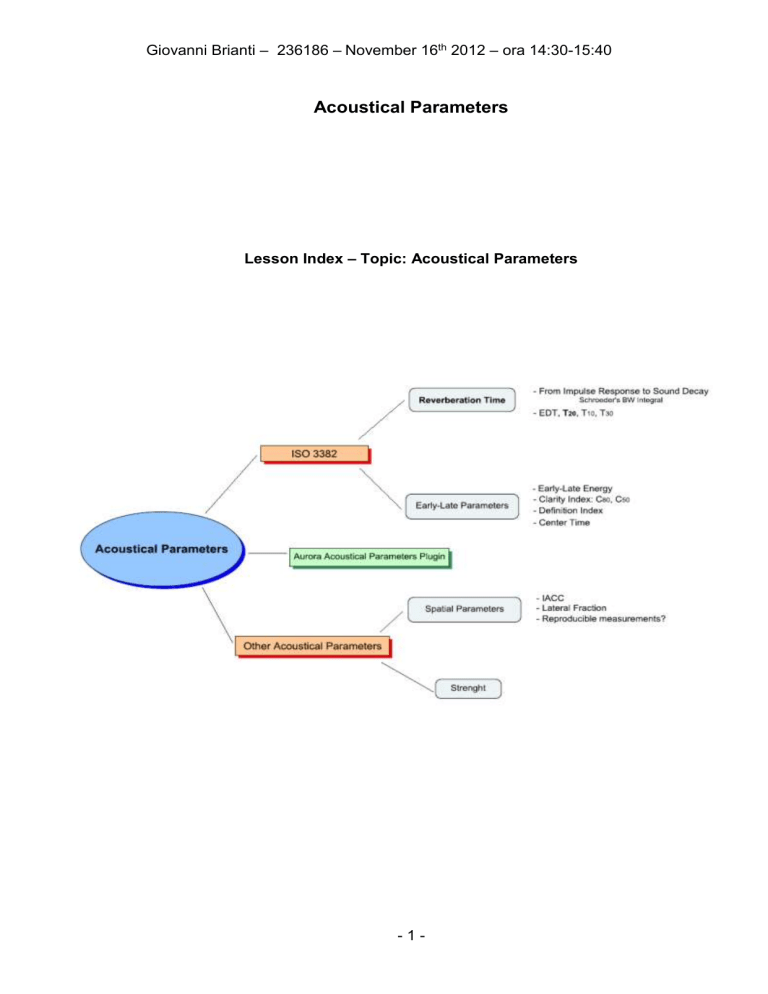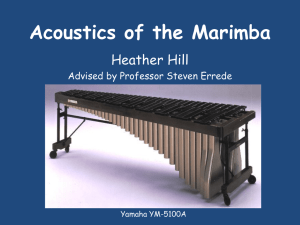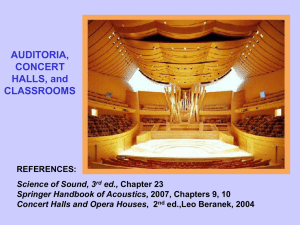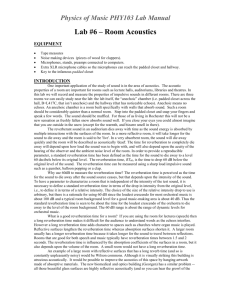Acoustical Parameters

Giovanni Brianti
– 236186 –
November 16 th 2012
– ora 14:30-15:40
Acoustical Parameters
Lesson Index – Topic: Acoustical Parameters
- 1 -
November 16 th 2012 – 14:30-15:40
The ISO 3382 Standard
This standard defines the acoustical parameters related to the analisys of the impulse response of a room and particularly is based on quality of the acoustic in terms of musical perception and speech intellegibility.
Fig.1 – ISO 3382 parameters.
From Impulse Response to Sound Decay
By the theoretical model:
Reverberation Time: time required for a sound decay of 60 dB.
But we are not having a source radiating a steady state sound with a costant power, we have a pulsive source .
We have a very short pulse (the direct sound radiated by the source), then a silence gap, then the first reflection (another pulse), then silence again, going to an increased temporal density of the reflections. This is not similar to the approximated linear sound level decay we can see switching off a steady state source.
- 2 -
November 16 th 2012 – 14:30-15:40
Fig. 2 – Pulsive Source and its reflections.
0
2
impulse response.
B
0
'
We need to perform a time integration for transforming the response of the room to a pulse into the response of the room to a steady state sound switched off.
The steady state level produced by a source which continuos radiating the same power of the pulse radiated by our pulsive source is a total time integral of the impulse response h (or g), a total sound pressure level:
A
t
2
'
L p , tot
o
h
2 dt ' (1)
0 t
We can compute the decay subtracting each energy arrival of each reflection from the total energy. This total value is a forward or upward running integral :
L p , forw
o
t h
2
dt ' (2)
The curve we are building is the total integral minus the running integral which comes back, thanks to the integral properties, to the backward integral
( Schroeder Backward Integral ):
L p , backw
t h
2
dt ' (3)
- 3 -
November 16 th 2012 – 14:30-15:40
0
'
B
0 t
2
' '
A
t
2
' '
0 t
Fig. 3 – Computing sound decay: Total integral, running integral and Schroeder BW Integral.
Schroeder BW Integral transforms impulse respose into the decay of a stationary source, obtaining a very accurate extimation of the shape of the curve, better than measurements with a real steady state source. This way we can measure an accurate reverberation time according to the ISO 3382 standard.
Fig. 4 – Stationary Sound Decay in dB (blue) obtained applying Schroeder BW to an
Energetic Impulse Response in dB (black).
- 4 -
November 16 th 2012 – 14:30-15:40
Reverberation Time
ISO 3382 doesn’t ask to measure reverberation time over a 60 db sound decay because of the signal to noise ratio, we can never wait for a 60 db decay. So the standard tells us to measure T
20
, defined as three times the time required for a 20 db decay. Every reverbation time is referred to a 60 db decay.
Fig. 5 – ISO 3382 Standard’s T
20
definition.
Actually the standard defines four reverberation times:
Early Decay Time ( EDT ), extrapolated from 0 to -10 dB
(discrete reflections region, not in the reverberant tale)
Reverberation Time T
10
, extrapolated from -5 to -15 dB
Reverberation Time T
20
Reverberation Time T
30
, extrapolated from -5 to -25 dB
, extrapolated from -5 to -35 dB
Early – Late Parameters
The Early-Late Energy concept is based on the subdivision of the reverberant tale in two parts: Useful Energy and Detrimental Energy . This distinction is not correct, our ears love reverb, (if we cut the last part of the response of a room it would sound dry, dead, so this means last part is important too), but we can search a proper balance between these two parts of the response.
- 5 -
November 16 th 2012 – 14:30-15:40
Fig. 6 – Distinction between Useful and Detrimental Energy.
In a room, in spite of the same reverberation time, we can find different responses moving the microphone in different positions, so we need others parameters above reverberation time.
Fig. 7 – IR measured near the source (a) and far from the source (b) in the same room.
Clarity Index C
80
(Symphonic Music):
C
80
10
lg
80 ms
p
0
80 ms p
2
2
dτ
dτ
Optimal value = +/-1 dB (4)
The boundary between useful and detrimental energy is set to be equal to 80 ms, the integration time of our brain when listening to music.
- 6 -
November 16 th 2012 – 14:30-15:40
This is a ratio between early and late energy, and its optimal value is 0 db: when early energy equate late energy.
Clarity Index C
50
(Speech):
C
50
10
lg
50 ms
0
p
50 ms p
2
2
dτ
dτ
Optimal value = +/-1 dB (5)
The boundary is set to be equal to 50 ms, the integration time for speech.
Definition Index D:
D
50
ms p
2
0
0 p
2
d
d
100 (6)
Equivalent of Clarity, used in North Europe. We use Clarity.
Center Time t s
: t s
0
0
p
2 p
2
d
d
(7)
There’s no pre-defined boundary, it’s the point of balance between the energy which is before and the energy which after. Optimal center time to listening to music is 80 ms, for speech is 50 ms.
This parameter can be very important in calibration of rooms for specific kind of music or speech: different genres of music need different balance between early and late energy for optimal listening (ex. Gregorian
– Rap music). Same concept for different languages.
- 7 -
November 16 th 2012 – 14:30-15:40
Other Parameters
Strenght G:
G
SPL
L w
31 dB (8)
Sound strength is the sound pressure level scaled on the sound power level of our sound source, it is the boost of the room.
This is very important for speech or for singing when the room must provide support. We subtract the SPL at 10 m from our SPL. This means that in the range of 10 m we have a boots because of the reflections.
Inter Aural Cross Correlation IACC:
T lim
1
2 T
T lim
1
2 T
T
T
T
T
p d
p d
2
dt
T
s
T t
dt
p s
2
t
dt
(9)
IACC is a spatial parameter defined as the correlation between the signal measured at the entrance of the ears of a dummy-head or of a true human head. Lower IACC means a high perception difference between the two microphones and so a good stereophony and envelopment.
Fig. 8 – Binaural Dummy Head.
- 8 -
November 16 th 2012 – 14:30-15:40
Fig. 9 – Binaural IR measurements. Calibrated on 80 ms for music.
Some reflections arrive louder to only one of the two microphones: those are lateral reflections and they help to perceive spatiality. Some others are the same in both the IR and can’t help to recognize direction of the sound: those are ceiling reflections for example.
Lateral Fraction J
LF
:
J
LF
5
80 ms
ms h
Y
2
80
0
ms ms h
W
2
d
d
(10)
Lateral Fraction is a spatial parameter defined as the ratio between the sound coming from a side and the whole sound. For measurement we can use a pressure-velocity microphone.
Fig. 10 – Pressure-velocity microphone.
- 9 -
November 16 th 2012 – 14:30-15:40
Fig. 11 – Pressure-velocity microphone measurements.
This time the two IR channels are not Left-Right but Omni-Figure of eight.
The integral start after 5 ms so, even if we haven’t placed the microphone facing the source (from top in Fig. 11), direct sound doesn’t affect our measurements.
Usually only one of the two spatial parameters is measured:
J
FL
1
IACC (11)
Measurements reproducibility
Testing different Dummy-Heads (for IACC) and Pressure-velocity microphones (for Lateral Fraction) in the same room with the same source and comparing the results we can see that these measurements are not very scientific and each dummy head/microphone can give a different result.
This means we can trust this measurements for spatial analysis only when comparated, we can’t take them as absolute.
- 10 -
November 16 th 2012 – 14:30-15:40
The Aurora Acoustical Parameters Plugin
Aurora software has a nice plugin for IR’s analysis which can give us all the parameters contained in the ISO 3382 standard. We can also isolate single frequency and observe IR and parameters resulting from the analysis.
Fig. 12 – Acoustical Parameters plugin.
- 11 -









